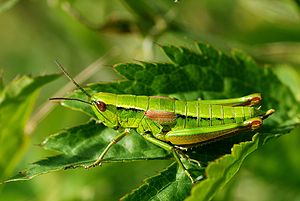Little golden insect
| Little golden insect | ||||||||||||
|---|---|---|---|---|---|---|---|---|---|---|---|---|

Little golden insect ( Euthystira brachyptera ), female |
||||||||||||
| Systematics | ||||||||||||
|
||||||||||||
| Scientific name | ||||||||||||
| Euthystira brachyptera | ||||||||||||
| ( Ocskay , 1826) |
The little golden insect ( Euthystira brachyptera , syn .: Chrysochraon brachyptera ) is a short-antennae insect from the family of field locusts . It is widespread in Central Europe.
features
The horrors reach a body length of 13 to 17 millimeters (males) or 18 to 26 millimeters (females). The males in particular look very similar to the great golden terrasse ( Chrysochraon dispar ). Both sexes are light green in their basic color and have a golden shimmer. Occasionally there are also individuals who have a gray, brown, golden or light blue basic body color. The females have strongly shortened pink or rarely yellow-green colored wings, which are clearly separated from each other on the back. The wings of the males are about half as long as the abdomen and are trimmed at the end. There are animals in both sexes in which the wings are not shortened. The knees of the yellow-green hind legs are colored brown.
distribution
The species occurs in Europe and Asia . Their distribution extends from the Pyrenees over France , Belgium , the Netherlands , the south and southeast of Germany , Poland , the CIS states to Siberia . Furthermore, Switzerland , northern Italy , Austria and Hungary , the former Yugoslavia , Bulgaria , Romania and northern Greece are settled. They are found in Central Europe at an altitude of 200 to 900 meters, in the Southern Alps also up to 2000 meters. They live in both moist and dry habitats, such as fens or grasslands . The adults occur from early June to September.
Way of life
The animals feed on herbivores of different grasses, such as from Woolly reed grass ( Calamagrostis villosa ). The females lay their eggs in egg packets of five to six pieces at a height of about 20 to 50 centimeters between folded leaves, mostly of grass, in a hardening, foamy liquid. This is preferably done in populations of the pinnate twinkles ( Brachypodium pinnatum ) or the blue pipe grass ( Molinia caerulea ) instead. The leaves are usually folded together with the hind legs, occasionally two leaves are used. After about 30 minutes the cocoons are already hardened and turn brown. In it, the eggs are protected from moisture or dehydration. The larvae hatch between late March and early May and develop into adults relatively quickly.
Courtship and mating
The singing of the males can be heard about ten feet away and consists of short verses made up of four to six separate syllables. At higher temperatures, however, the single syllables blur into a brief whirring sound. Male responds to calls from competitors. Verses with two to five syllables are generated. The female cannot make any sounds due to the greatly shortened wings. Mating is only successful if the female is actively involved. If this is not the case, the male will attempt copulation, but will loosen his genitals after a few seconds.
swell
literature
- Heiko Bellmann: Locusts: observe, determine , Naturbuch Verlag 1993, ISBN 3-894-40028-5
- Peter Detzel: The locusts of Baden-Württemberg. Verlag Eugen Ulmer GmbH & Co, Stuttgart 1998, ISBN 3-8001-3507-8 .
- Siegfried Ingrisch, Günther Köhler: The locusts of Central Europe , Westarp Sciences 1998, ISBN 3-894-32461-9
- Josef Szij: The jumping horrors of Europe , The New Brehm Library Volume 652, Westarp Sciences Hohenwarsleben 2004, ISBN 3-894-32910-6
Web links
- Euthystira brachyptera at Fauna Europaea
- Euthystira brachyptera at Orthoptera.ch


